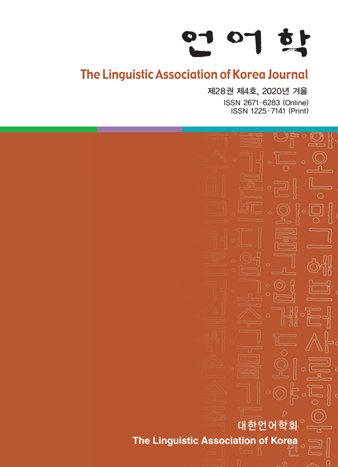대한언어학회 전자저널

28권 4호 (2020년 12월)
- Semantic Taxonomy and NP-coordination in Korean
-
Juwon Lee
Pages : 147-174
Abstract
Lee, Juwon. (2020). Semantic taxonomy and NP-coordination in Korean. The Linguistic Association of Korea Journal, 28(4), 147-174. This paper discusses the novel data of Korean NP-coordinations whose non-final conjunct is semantically incompatible with the verb of which the NP-coordinations are the object in a sentence. It is shown that these peculiar NP-coordinations cannot be accounted for by prior approaches to coordination in the literature. In particular, any theory that directly relates the verb with such a non-final conjunct faces a significant problem of semantic incompatibility. As a solution to this problem, I propose the hypothesis that the non-final conjunct of such NP-coordination must be semantically associated with the direct hypernym of the verb. I focus on conjunctive coordinations in this paper, but it is shown that the hypothesis can be further supported by some disjunctive coordinations in Korean.
Keywords
# NP-coordination # right node raising # deletion # multiple dominance analysis # semantic taxonomy # hypernym
References
- Abbot, B. (1976). Right node raising as a test for constituenthood. Linguistic Inquiry, 7, 639-642.
- Choe, H.-S. (1988). Restructuring parameters and complex predicates: A transformational approach. Unpublished doctoral dissertation, Massachusetts Institute of Technology.
- Chomsky, N. (1957). Syntactic structures. The Hague: Mouton.
- Chung, D. (2004). A multiple dominance analysis of right node sharing constructions. Language Research, 40, 791-811.
- Dougherty, R. C. (1970). A grammar of coordinate conjunction, I. Language, 46, 850-898.
- Dougherty, R. C. (1971). A grammar of coordinate conjunction, II. Language, 47, 298-339.
- Fiengo, R., & Robert, M. (1994). Indices and identity. Cambridge: MIT Press.
- Goodall, G. (1987). Parallel structures in syntax: Coordination, causatives and restructuring. Cambridge: Cambridge University Press.
- Haspelmath, M. (2004). Coordinating constructions. Amsterdam: John Benjamins.
- Höhle, T. (1991). Assumptions about asymmetric coordination in German.
- In J. Mascaró & M. Nespor (Eds.), Grammar in progress (pp. 221-235). Dordrecht: Foris.
- Hudson, R. A. (1970). On clauses containing conjoined and plural noun-phrases in English. Lingua, 24, 205-253.
- Hudson, R. A. (1976). Conjunction reduction, gapping, and right-node raising. Language, 52(3), 535-562.
- Kayne, R. (1994). The antisymmetry of syntax. Cambridge: MIT Press.
- Kim, C. (2005). The Korean plural marker tul and its implications. Unpublished doctoral dissertation, University of Delaware.
- Kim, J.-S. (2006). Against a multiple dominance analysis of right node sharing constructions in Korean and Japanese. Studies in Modern Grammar, 42, 123-147.
- Kim, J.-B., & Yang, J. (2006). Coordination structures in a typed feature structure grammar: Formalization and implementation. Lecture Notes in Artificial Intelligence, 4139, 194-205.
- Lakoff, G., & Peters, S. (1966). Phrasal conjunction and symmetric predicates. Cambridge: Harvard University Computation Laboratory.
- Lee, J. (2016). Lexicology of Korean common nouns. Korean Journal of Linguistics, 41(4), 715-739.
- Lee, J. (2017). Semantic taxonomies and tasi ‘again’ in Korean. The Linguistic Association of Korea Journal, 25(4), 59-81.
- McCawley, J. D. (1968). The role of semantics in a grammar. In E. Bach & R. T. Harms (Eds.), Universals in linguistic theory (pp. 125-170). New York: Holt, Rinehart & Winston.
- McCawley, J. D. (1982). Parentheticals and constituent structure. Linguistic Inquiry, 13, 91-106.
- Merchant, J. (2004). Fragments and ellipsis. Linguistics and Philosophy, 27(6), 661-738.
- Merchant, J. (2013). Voice and ellipsis. Linguistic Inquiry, 44(1), 77-108.
- Merchant, J. (2016). Ellipsis: A survey of analytical approaches. In J. van Craenenbroeck & T. Temmerman (Eds.), The Oxford handbook of ellipsis (pp. 19-45). Oxford: Oxford University Press.
- Moltmann, F. (1992). Coordination and comparatives. Unpublished doctoral dissertation, Massachusetts Institute of Technology.
- Muadz, H. (1991). Coordinate structures: A planar representation. Unpublished doctoral dissertation, University of Arizona.
- Park, M.-K. (2006). Displacement effects by multi-dominance in right node raising constructions. The Linguistic Association of Korea Journal, 14(1), 37-65.
- Park, M.-K. (2007). RNR in Korean as right-edge coordination. Studies in Generative Grammar, 17(1), 85-97.
- Postal, P. (1974). On raising: One rule of English grammar and its theoretical implications. Cambridge: MIT Press.
- Pustejovsky, J. (1995). The generative lexicon. Cambridge: MIT Press.
- Wexler, K., & Culicover, P. (1980). Formal principles of language acquisition. Cambridge: MIT Press.
- Wilder, C. (1997). Some properties of ellipsis in coordination. In A. Alexiadou & T. Hall (Eds.), Studies on universal grammar and typological variation (pp. 59-106). Amsterdam: John Benjamins.
- Wilder, C. (1999). Right node raising and the LCA. In S. Bird, A. Carnie, J. D. Haugen, & P. Norquest (Eds.), Proceedings of the 18th West Coast Conference on Formal Linguistics (WCCFL) (pp. 586-598). Somerville: Cascadilla Press.
- Williams, E. (1990). The ATB theory of parasitic gaps. The Linguistic Review, 6, 265-297.